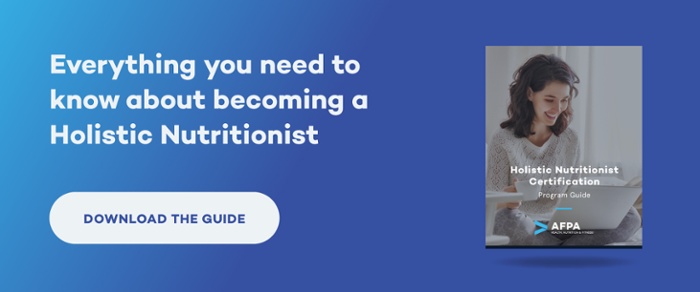Hippocrates, the ancient Greek philosopher and father of medicine, famously said, “Let food be thy medicine, and let medicine be thy food.”
It is not new knowledge that what we eat has a significant impact on our health. Before having the epidemiological data to back it up, Hippocrates knew that our diet could help to prevent and treat or manage illness and disease.
While there is no such thing as “the perfect diet,” we now have access to information that helps us understand how certain types or groups of food and nutrients, when consumed as part of our regular diet, influence our health.
In this article, we summarize nationwide data on how dietary factors influence disease risk. We then put the research into context and provide five tips for how to use the information in your nutrition and wellness coaching practice.
What Are Dietary Factors?
Dietary factors are those that are directly related to eating habits. These include what you eat, how much you eat, and how often you eat them.
Some specific examples of dietary factors include:
- How many servings of different food groups you normally eat over a given time period
- How often and in what quantity you consume specific nutrients
- The variety of foods you eat
- The quality of foods you eat
- The level of processing of foods you eat
- How you cook and prepare your foods
- When you choose to eat
- How much you normally eat
- The nutritional components and phytonutrients you consume through your diet
Thanks to the predominance of diet culture in the West, the word “diet” is often used to refer to a restrictive pattern of eating with the goal of achieving a certain physique.
However, from a nutritional health perspective, diet refers to a regular pattern of eating. In other words, a person’s diet is what they normally eat. So, when we refer to dietary factors, we are referring to those that make up what your diet looks like in terms of whole foods, nutrients, quantity, frequency, and quality.
How Dietary Factors Influence Disease Risk
Chronic diseases have the potential to negatively affect all dimensions of a person’s wellness, diminish the quality of life, and shorten life expectancy.
In the US, six in ten people have a chronic disease, and four in ten people have two or more chronic diseases. Learn more in our guide to Chronic Disease in the US.
These devastating numbers have led researchers and public health specialists to examine what can be done to reduce the incidence and prevalence of chronic diseases.
Many of the most common chronic diseases are largely preventable.
The risk of developing a chronic disease can be lowered if a person carries out regular physical activity, has access to quality and affordable health care and early disease screening and follows a diet that provides a health-promoting balance of nutrients.
The National Institutes of Health (NIH) analyzed the CDC’s National Health and Nutrition Examination Survey (NHANES) to understand how dietary factors influence the risk of developing specific chronic diseases.
The study estimated the intake of ten specific dietary factors with death due to heart disease, stroke, and type 2 diabetes—three of the most common cardiometabolic chronic diseases among people in the US.
More specifically, the dietary factors examined were the consumption of specific foods and nutrients:
- Fruits
- Vegetables
- Nuts/seeds
- Whole grains
- Unprocessed red meats
- Processed meats
- Sugar-sweetened beverages
- Polyunsaturated fats
- Seafood omega-3 fats
- Sodium
The dietary factors that had the greatest association with death due to cardiometabolic diseases included:
- high sodium (66,508 deaths in 2012; 9.5% of all cardiometabolic deaths)
- low nuts/seeds (59,374; 8.5%)
- high processed meats (57,766; 8.2%)
- low seafood omega-3 fats (54,626; 7.8%)
- low vegetables (53,410; 7.6%)
- low fruits (52,547; 7.5%)
- high sugar-sweetened beverages (51,694; 7.4%).
The researchers concluded that dietary factors were estimated to be associated with a substantial proportion of deaths from heart disease, stroke, and type 2 diabetes and recommended that the data be used to guide public health planning and to inform strategies to alter dietary habits that can increase disease risk.
NOTE: The researchers that carried out this analysis published the study in 2017. Here, we have summarized the most recent analysis of this type available, which compares data from 2002 and 2012.
“Just Make Better Choices!” Choice Is Only One Element that Influences Dietary Factors
It is often understood that dietary factors are among the few things over which we have complete control in terms of our health. Since dietary factors are related to what we eat and how often we eat it, we generally understand these to be choices we make.
While in most cases, there is an important decision component to dietary factors that influence our health, there are multiple other factors that have a direct and indirect impact on what our choices are and, ultimately, our habits.
Habits are patterns of individual actions, and individual actions result from a complex interaction between psychological, social, and environmental factors.
When it comes to dietary factors and other health behaviors, internal or personal forces actively or passively influence our habits.
As we discuss in-depth in this article, health behaviors result from a complex interaction between decisions, preferences, habits, emotional state, social support, historical experiences with discrimination, access to healthcare and education, trauma, culture, economic access, and others factors.
In different populations, the factors that influence dietary habits and behaviors change. For example, in a study with international college students, researchers found that the factors that influenced dietary factors and habits included the food environment, the campus environment, religion, and individual preferences.
In another study with young women, researchers found that some of the most important factors influencing food choice included current physical health, time, marketing price, and the quality of food.
In yet another study with adolescents in low- and middle-income settings, researchers found that the factors that most influence health behaviors included socio-cultural changes, including increased workload and changes in food patterns; availability and accessibility, including parenting practices, financial constraints, and school practices; and individual factors, including attitudes, beliefs, habit strength, preferences, and perceived food safety.
After reviewing the research, it is clear that the elements that influence dietary factors and habits are complex and varied and can change significantly based on a person’s age, environment, cultural background, gender, and relationship with others. In fact, what influences dietary factors likely changes over the course of a person’s lifetime.
Become a Certified Holistic Nutritionist Online in 6 Months or Less
Other Factors that Influence Disease Risk
Diet is just one of the factors that influence your risk of chronic disease. Other well-studied factors include:
- Genetics (this is a big one!)
- Physical activity and exercise
- Food and nutrition insecurity
- Exposure to environmental toxins
- Toxic stress
- Chronic stress
- Smoking, drinking alcohol and taking drugs
- Other current diseases and conditions
Even if a person eats a diet that is the exact opposite of the one described in the study above (high in sodium, low in nuts and seeds, high in processed meats, low in seafood omega-3, etc.), they may still be at risk of developing a chronic disease. In different people, the various factors may have more or less weight on their health outcome.
How Nutrition and Wellness Coaches Can Support Clients to Eat a Health-Promoting Diet
Health coaching is a proven way to improve the health outcomes of clients. To continue along this line and deepen the positive impact, it is essential to be sensitive to the complex nature of food choices.
Here are five ways you can support clients in building a sustainable, health-promoting diet.
Avoid One-Size-Fits-All Dietary Approaches
Standardized dietary regimens rarely work. The role of nutrition and wellness coaches is to build plans that work for clients based on their needs, cultural desires, preferences, and limitations.
Making dietary recommendations or meal plans without listening to your client first will likely result in a short-lived relationship, and if they can’t meet your expectations and don’t feel comfortable telling you about it, they will likely be untruthful.
One-size-fits-all dietary approaches are more likely to result in:
- A feeling of failure
- Low “adherence” to the dietary regimen
- Low levels of trust in the coach-client relationship
- Low levels of empowerment
- Limited ability or willingness to stick to the recommendations
- Your client feeling like you aren’t taking their culture, values, desires, or limitations into account
- Your client wanting to go somewhere else
Instead, spend time getting to know your client and use the health-promoting diet
Adopt a Whole Diet Approach
A common mistake health and wellness professionals make when talking about a health-promoting diet is singling out specific foods and either blaming them for all of the world’s health problems or believing they can save us from all of our health woes.
Foods and nutrients are not inherently “good” or “bad.” Foods are just foods. No one food can make or break your health. We do know, however, that the frequency and quantity with which we eat or don’t eat certain foods on a regular basis can influence our health.
Unless your client has allergies, aversions, intolerances, or conditions that have a specific detrimental reaction to certain components, like diabetes or celiac disease, avoid singling out specific foods. Singling out foods or nutrients can lead to shame and is rarely helpful. If you restrict them, it can lead to disordered eating, and if you hail them, it can cause your client to feel defeated if they don’t like that food, can’t afford it, or don’t have access to it.
Instead, understand your clients’ regular eating habits, including the frequency with which they consume foods, the quantities, and how they prepare them. Be open to learning about culturally appropriate foods and how they fit into your clients’ overall diet.
You can mention specific foods in lists as examples of foods that may be helpful to your client. For example, if you think your client may benefit from eating more fiber, you can mention that fruits, vegetables, and whole grains are rich in fiber. Then, have a conversation with your client to identify which foods in these groups they regularly have access to and enjoy.
After Getting Permission, Offer Information as It Is Relevant
As a health coach, you are knowledgeable about up-to-date research on lifestyle factors that promote health and those that can be detrimental to health.
Sometimes, your client may not know how certain behaviors may be influencing their health. First, ask them about their understanding of how what they normally eat may be influencing their health.
After gauging their level of understanding, ask them for permission to offer information. This can be useful, but make sure to keep these principles in mind:
- Avoid overwhelming them with information. Offer one piece of information directly relevant to the issue they want to address and focus on that.
- Make sure the information you offer is scientifically sound. If it is a theory, a fad diet, or something you recently read without seeing the literature, then keep it to yourself as it may do more damage than good.
- Ask them if and how they think the information is relevant to them. This can help them make parallels between the information you offered and their current situation. It may also open the opportunity for them to explore the idea of making changes without your prompting it.
- Your client may show resistance to the information or feel like it is not relevant to them. It is important to respect this boundary and move on by asking them what they would like to focus on.
Show Empathy for What Is Out of Your Client’s Control
Our society has the common misconception that knowing what foods, food groups, and nutrients support health and those that may increase disease risk should be enough to inspire people to make changes in their diet.
As discussed in the sections above, multiple factors influence what we eat and how often we eat them—and for some individuals and communities, there may be more factors out of their control than for others.
Avoid blaming or shaming a person for their food choices. Instead, with your client’s permission, have open discussions about the food environment where they live and work, what they have access to, and what leads them to make the choices they do. Consider environmental, social, and psychological factors in the discussion as well.
Once you understand their current situation, with their permission, offer words of support and encouragement. They may be overly critical of their habits to the point where it may be damaging their emotional wellbeing.
Let them know you understand their situation. If you have experienced something similar, you may want to share your experience. If you haven’t, it is important to tell them that while you have never experienced it yourself, you understand that their response to their environment is very normal.
Identify several of the ways they have positively responded to barriers and difficulties and congratulate them for it.
Work with Your Client to Build a Plan that Empowers Them
The advantage of health coaching is that you can build long-term relationships with your clients. Over several sessions, you can understand what their goals and challenges are. You can also guide them toward understanding if and what they would like to change about their current behaviors and how they feel comfortable doing it.
When you stand on equal footing with your clients, not only do you build trust, but they also provide you the blueprint for what will work for them. By using a trauma-informed health behavior change approach, including motivational interviewing techniques, you can respectfully support your client in adopting dietary habits that support their health.
Main Takeaways
The data uncovered by the NIH’s analysis of the National Health and Nutrition Examination Survey may not surprise you. You may have already known that diets high in sodium and sugar-sweetened beverages and low in foods containing polyunsaturated and monounsaturated fats are associated with health issues. The study demonstrates the level of influence these dietary factors have on cardiometabolic death risk. This is important to know, but it can also be easily misconstrued and taken out of context.
Having dietary knowledge is an important starting point when working with your nutrition and wellness clients, but it is only relevant to them when grounded in their experiences, preferences, limitations, and the context over which they have no control.
You can use the principles of respect, understanding, communication, empowerment, asking for permission, and showing empathy to use the knowledge on the dietary factors that influence disease risk in the way that is most relevant and useful to your clients.




